The Petrified Forest Blu-ray Movie
HomeThe Petrified Forest Blu-ray Movie 
Warner Bros. | 1936 | 82 min | Not rated | May 21, 2013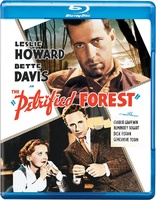
Movie rating
7.5 | / 10 |
Blu-ray rating
| Users | 4.5 | |
| Reviewer | 4.0 | |
| Overall | 4.2 |
Overview
The Petrified Forest (1936)
A waitress, a hobo and a bank robber get mixed up at a lonely diner in the desert.
Starring: Leslie Howard, Bette Davis, Genevieve Tobin, Dick Foran, Humphrey BogartDirector: Archie Mayo
| Drama | Uncertain |
| Romance | Uncertain |
| Crime | Uncertain |
Specifications
Video
Video codec: MPEG-4 AVC
Video resolution: 1080p
Aspect ratio: 1.37:1
Original aspect ratio: 1.37:1
Audio
English: DTS-HD Master Audio Mono (48kHz, 24-bit)
Spanish: Dolby Digital Mono
German: Dolby Digital Mono
Portuguese: Dolby Digital Mono
Subtitles
English SDH, French, German SDH, Portuguese, Spanish
Discs
25GB Blu-ray Disc
Single disc (1 BD)
Playback
Region free
Review
Rating summary
| Movie | 4.5 | |
| Video | 4.5 | |
| Audio | 4.0 | |
| Extras | 3.0 | |
| Overall | 4.0 |
The Petrified Forest Blu-ray Movie Review
An Icon Is Born
Reviewed by Michael Reuben May 16, 2013Note: "The Petrified Forest" is available either separately or as part of the Warner Ultimate Gangsters Collection: Classics. The Petrified Forest isn't exactly a gangster movie, but it became famous for one gangster character, Duke Mantee, who was played by a then-unknown actor named Humphrey Bogart—an unusual name that Warner Brothers tried to get Bogie to change. Already 36 when the film was released, Bogart had enjoyed modest success as a Broadway actor, but an early stint under contract to Fox had ended with the studio releasing him from his contract and sending him home to New York. There he continued to be typecast in a succession of preppy roles wearing white pants and holding a tennis racquet—Bogart is supposed to have been the first stage actor to speak the line, "Tennis, anyone?"—until the producer of Robert E. Sherwood's new play, The Petrified Forest, cast him as Duke Mantee. The producer later said that, while Bogart didn't look like a killer, he had the voice of one. The Broadway production of The Petrified Forest was a success, and star Leslie Howard (best known today as gentle Ashley Wilkes in Gone with the Wind) largely credited Bogart, whom critics singled out for his chilling performance as a cold-blooded gangster. When Warner Bros. set out to adapt Sherwood's play for film, they wanted to recast the part with familiar bad guy Edward G. Robinson, but Howard was adamant: No Bogart, no picture. Warner had little choice, since Howard controlled the rights to Sherwood's play. Years later, Bogart would name his daughter with Lauren Bacall "Leslie" in honor of the fellow actor who had stuck by him and, as things turned out, changed his life. Bogart's Duke Mantee does not appear until halfway through The Petrified Forest, but other characters repeatedly talk about him before he does. As with Orson Welles in The Third Man, having your character be the subject of everyone's fascination is almost better than screen time. By the time he does appear, everyone, both on and off the screen, is eagerly anticipating his arrival. Having played the part for live audiences night after night, Bogart already understood that dynamic, and he knew how to exploit it for maximum effect with the smallest of gestures.
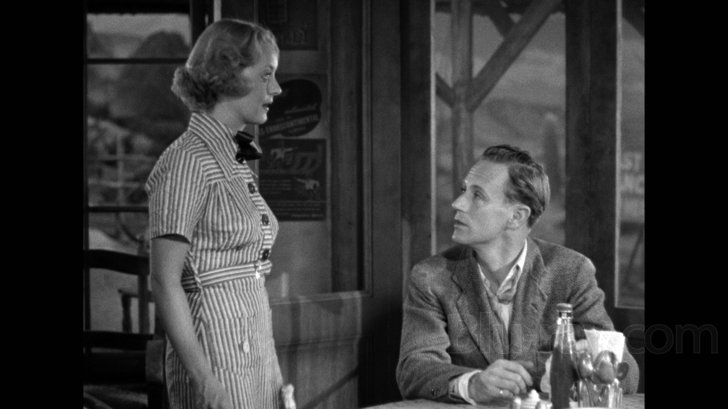
Like Sherwood's play, the film is set in a remote roadside diner and gas station in northeast Arizona on the edge of the region of fossilized trees that was declared a national monument in 1906. (It is now a national park.) The screenwriters, Charles Kenyon and Delmer Davies, made minor changes to shift a few scenes outdoors, and the director, Archie Mayo, worked so hard at finding interesting angles within the diner set that the production fell behind schedule, incurring the wrath of Warner's head of production, Hal Wallis. At this venue on the outskirts of civilization, Sherwood orchestrates a collision of troubled souls, all of them semi-fossilized into some sort of spiritual torpor from which they cannot or will not rouse themselves. Chief among them is Alan Squier (Howard), a penniless vagrant and drifter, who speaks beautifully, because he used to be a writer and intellectual, but now he can't even do that. During the course of one long evening, Squier relates the highs and lows of his life to Gabrielle Maple (a luminous Bette Davis), the daughter of the establishment's owner (Porter Hall). Although Squier puts a romantically tragic gloss on his tale, it amounts to nothing more than talent wasted and opportunity squandered. To Gabrielle, however, Squier appears as a messenger from a mysterious world of potential beyond the diner where she feels trapped. The daughter of a World War I veteran and a French bride who fled the stifling confines of their marriage shortly after Gabrielle was born, the young woman yearns to discover what is out there, especially in the mysterious land of France from which her mother writes occasional letters and sends books of poetry. Secretly, Gabrielle paints and aspires to study art, but her practical side—the side that dutifully cooks, cleans and waits on customers for her father's business—feels that she'll never leave the petrified forest. It's that same practical side that coolly assesses former college football star Boze Hertzlinger (Dick Foran), who pumps gas and works in the garage, and like many ex-jocks, thinks no woman can resist his charms. Gabrielle could easily resist Boze's minimal charms, but she's thinking of settling for what she can get—that is, until Squier walks in. Gabrielle's grandfather, known only as "Gramp" (Charley Grapewin), provides the film's comic relief. An irreverent old codger, whom both Gabrielle and her father are trying to keep away from drink, Gramp will tell anyone who will listen (and even those who won't) about being shot at and missed by the infamous Billy the Kid. Gramp's sympathies are always with the outlaw. When the radio buzzes with emergency announcements that notorious killer Duke Mantee (Bogart) is at large, armed and dangerous, with the police in hot pursuit, Gramp immediately sides with Mantee. Before the night is over, the group is expanded by the presence of a wealthy married couple, Mr. and Mrs. Chisholm (Paul Harvey and Genevieve Tobin), returning by chauffeured limousine from a holiday that obviously didn't go well. Their hauteur masks simmering resentments that introduce an unpredictable element into a situation that quickly turns deadly when Duke Mantee arrives with his two henchmen, Ruby and Slim (Adrian Morris and Slim Thompson). While a police dragnet combs the region, Mantee and his men hold everyone hostage in the diner, awaiting the arrival of Mantee's girlfriend for a prearranged rendezvous, after which they'll flee to Mexico. Mantee's insistence on waiting for this woman is the only hint of emotion that he ever reveals. In his original play, Sherwood based the character of Duke Mantee on John Dillinger, and Bogart studied Dillinger to develop his performance. In contrast to the restless energy displayed by Edward G. Robinson's Rico in Little Caesar or James Cagney's Tom Powers in The Public Enemy, Mantee is withdrawn, dead-eyed and economical in both word and action. If there was ever any joy for Mantee in living outside the law, he exhausted it long ago. At this point in his criminal career, everything is about survival, and maybe an occasional amusement, such as the odd "proposition" that Alan Squier makes to Mantee out of nowhere. To watch Squier and Mantee square off against each other is to witness characters from two different worlds, and two radically different acting styles, reaching out to agree on one bleak truth—that life is a hopeless mess. For such a delicate dance, it's no wonder that Leslie Howard insisted on having a partner he already knew could do the steps perfectly. The studio was so concerned about Sherwood's original ending that they forced director Mayo to shoot an alternate conclusion, which preview audiences hated. (Unfortunately, it was not preserved.) The Petrified Forest was released with the same ending as the play, and the film jump-started Bogart's career and moved Bette Davis to a new level of stardom. It's her Gabrielle who ends the story with a chance of making something more of her life than just another fragment among the rocks.
The Petrified Forest Blu-ray Movie, Video Quality 
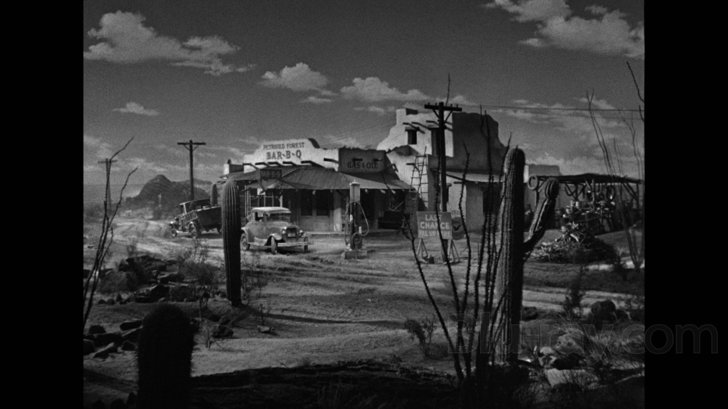
The Petrified Forest was shot by Sol Polito, one of the studio's top cinematographers during the Thirties and Forties and a key architect of the Warner visual style in that period. The source material for this 1080p, AVC-encoded Blu-ray has been wonderfully preserved (or restored) with minimal visible damage and none of the major scratches or frame jumps that are visible on Little Caesar. Sharpness and detail are impressive for a film of this vintage, in large part due to the transfer's accurately rendered blacks, properly calibrated whites and correctly graduated shades of gray. Polito was noted for his ability to light Bette Davis, and at times in The Petrified Forest she almost pops out of the frame, although you can't quite identify where the additional light is coming from. Detail doesn't falter even in the brief sequence where several characters leave the diner and venture out into the night. The surroundings become darker, but faces and objects remain readily identifiable. The grain structure is natural and film-like without being obvious or intrusive. No digital manipulation that would generate noise, ringing or other undesirable artifacts appears to have been performed, and the healthy average bitrate of 24.00 Mbps is consistent with the lack of any observed compression errors.
The Petrified Forest Blu-ray Movie, Audio Quality 
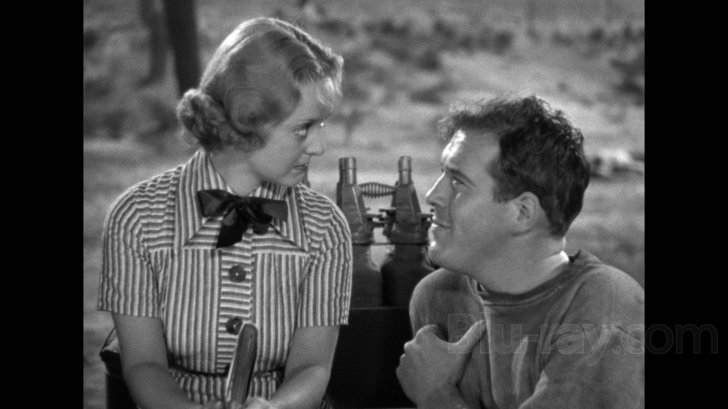
The film's original mono track is included in lossless DTS-HD MA 1.0, and it sounds just fine, with a nice balance of clear vocals, desert winds, radio bulletins and the sounds of a working diner. There's an appropriately moody score by Warner in-house composer Bernhard Kaun (uncredited), but by far the greatest challenge for the film's audio track is reproducing Leslie Howard's nimble vocal performance. He delivers a lot of dialogue, often very fast, with all the practiced ease of an experienced British thespian.
The Petrified Forest Blu-ray Movie, Special Features and Extras 
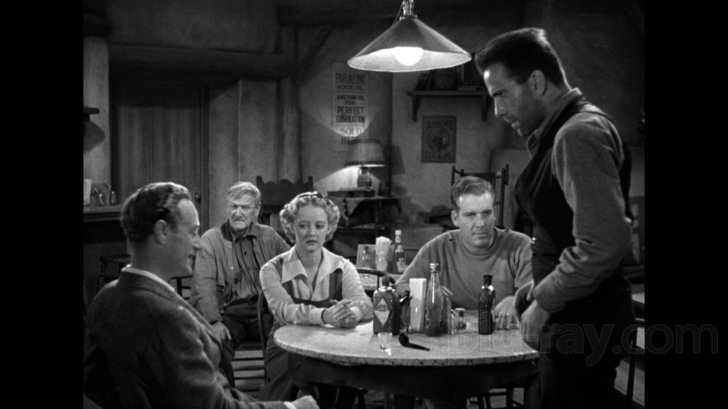
- Commentary with Eric Lax: Lax is a film scholar and a biographer of Bogart, who also appears in the "Menace in the Desert" featurette described below. He talks continuously, although it is obvious that he is reading from prepared notes. His commentary is dense with historical information about each of the major, and some of the minor, cast in The Petrified Forest, as well as the history of its production and related subjects.
- Warner Night at the Movies 1936
- Introduction by Leonard Maltin (480i; 1.33:1; 3:14): The well-known critic and film historian provides an introduction to the various 1936 items listed below.
- "Bullets or Ballots" Theatrical Trailer (480i; 1.33:1; 3:02): Bullets or Ballots was a 1936 gangster film featuring both Bogart and Edward G. Robinson.
- Newsreel (480i; 1.33:1; 3:24): Highlighting two stories: the abdication of England's King Edward VIII, and the re-election of American President Franklin Roosevelt.
- Short Feature: "Rhythmitis" (480i; 1.33:1; 19:37): This lively short uses the plot device of a wonder drug that induces "rhythmitis", i.e., fabulous dancing. The performances by noted Broadway dancer Hal Le Roy are remarkable.
- Cartoon: "The Coo Coo Nut Grove" (480i; 1.33:1; 6:46): A "Merry Melody" composed almost entirely of caricatures of movie stars.
- The Petrified Forest: Menace in the Desert (480i; 1.33:1; 15:51): A group of scholars and critics discuss the film's place in the history of Warner Bros., gangster films and film noir, among other topics.
- 1/17/1940 Gulf Screen Radio Broadcast (audio only; 28:58): A radio version of The Petrified Forest in which Bogart reprised his star-making role.
- Theatrical Trailer (480i; 1.33:1; 4:16): "It's one of the most unusual stories ever brought to the screen!"
The Petrified Forest Blu-ray Movie, Overall Score and Recommendation 
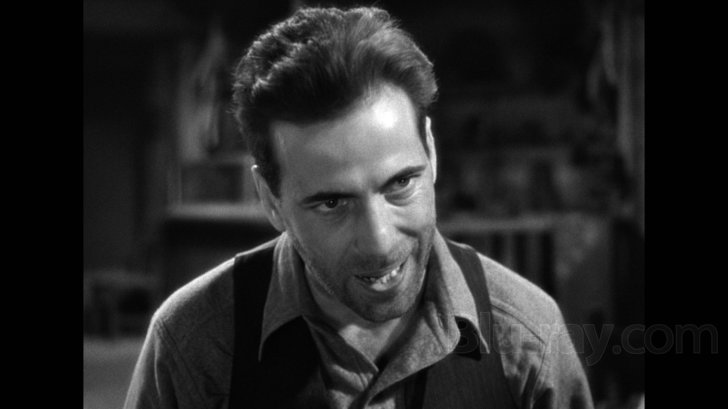
It can be a disorienting experience for viewers who know Bogart primarily as Rick in Casablanca, Sam Spade in The Maltese Falcon or Philip Marlowe in The Big Sleep to experience his performance as Duke Mantee. Mantee has none of the rogue's charm that has made Bogart's more famous characters endure. But in 1936, Bogart had yet to play such heroes. New to most movie viewers, he impressed them with the sheer chill of Mantee's detachment and the coldness of his deadly eyes. If you watch The Petrified Forest waiting for the familiar Bogie persona to appear, you'll be disappointed. Warmth was Leslie Howard's department. Bogart's was to be cruel, and he succeeded beyond all expectations. Highly recommended.
Similar titles
Similar titles you might also like

Little Caesar
1931

The Public Enemy
1931

Pierrot le fou
1965

Boxcar Bertha
1972

Port of Shadows
Le quai des brumes
1938

Bonnie and Clyde
1967

White Heat
1949

Kept Husbands
1931

The Vanishing of Sidney Hall
2017

Morocco
1930

Frank & Lola
2016

Thieves Like Us 4K
Standard Edition
1974

Blood on the Sun
1945

Tess
1979

The Bitter Tea of General Yen
1933

The Whole Town's Talking
Limited Edition to 3000
1935

Grand Hotel
1932

Imitation of Life
1934

Gabriel Over the White House
Warner Archive Collection
1933

The L-Shaped Room
Limited Edition to 3000
1962